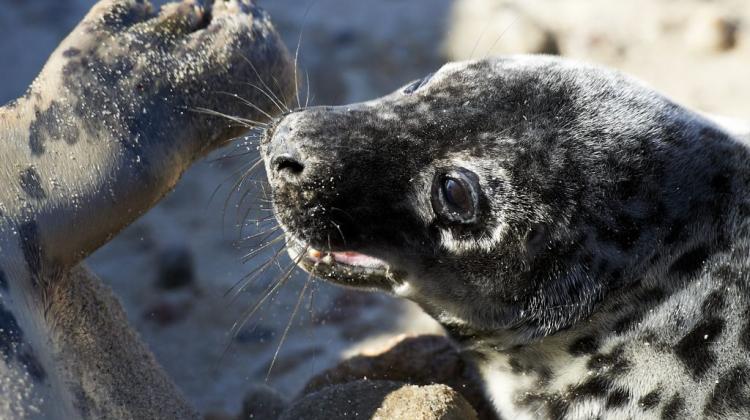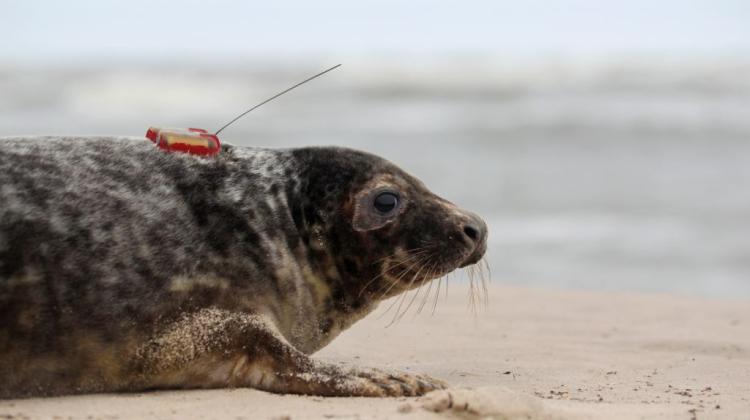Seal also wants to rest on the Baltic Sea beach

While resting on a Polish beach, we encounter seals more and more often. In late July, at the mouth of the Vistula a group of as many as 77 grey seals was recorded, more than three times larger than in 2011. Unfortunately, number of seals found dead is also growing rapidly.
In the refuge "Seals\' Sandbank" at the mouth of the Vistula River, the place of choice for most seals to rest, a group of 77 grey seals was observed in late July. That\'s three times more than in 2011, when the largest group consisted of 25 animals, and slightly more than in 2012 when 61 seals were reported, according to data from Marine Station of the University of Gdańsk and WWF Polska.
University of Gdańsk professor Krzysztof E. Skóra of the Hel Marine Station explained that alive and dead seals are recorded throughout the Polish coast. "These animals are still a great sensation on Polish beaches. Many people try to approach a seal, take a picture - and they shouldn’t. Coast is a place to rest for seals and they must be left alone" - Prof. Skóra explained in an interview with PAP.
Seal on the beach should not be surprising. "Seal has to come ashore from time to time, to dry the fur, it\'s kind of sealskin hygiene. Otherwise its fur, like a ship\'s hull, would become covered with algae and shells of sedentary species of invertebrates. Since the seal hunts in the sea and moves from place to place, especially in the pursuit of herrings, it must also simply rest. Rest and quiet on the shore is as important to these animals as sleep is to us" - explained the scientist.
If you see a seal on the beach, the most important thing to do is not to disturb it. "You definitely should not touch the seal, because it could end very badly. Its bite may cause even amputation of the hand or fingers" - warned Krzysztof Skóra.
Scientists are considering marking special seal refuge grounds, the places where these animals are particularly often found. "Because seals are moving, we would not give this protection the form of a reserve, we rather prefer to ask people for a certain restraint in the places which seals consider their own. If people do not understand this, more rigorous regulations application will become a necessity" - says Krzysztof Skóra.
Unfortunately, the number of grey seals found dead increases every year. In 2011, 40 dead seal were found, and 42 in 2012. By the end of July 2013, there were more than 80. "We do not really know why so many of them are killed. It is important to determine whether the degree of population loss is higher than the rate of annual births. If we determine that the mortality rate is higher than the birth rate, we will have a problem" - admitted the researcher.
He explained that today in Poland it would be easier to find a dead seal than to see one alive. Polish straight coastline with the western and northern winds is particularly exposed to their dead bodies being washed ashore. For that reason, in many places on the Polish coast there are boards informing tourists which service to call if they find a dead Baltic Sea mammal - a seal or porpoises. Another helpful initiative it the "Blue Patrol" organized by WWF and the Marine Station in Hel, whose members are the first to reach the weak or sick, and unfortunately often dead seals.
For now, the number of grey seals in the Baltic grows. "In the nineteenth century there were approximately 90-100 and 200 thousand ringed seal in the Baltic. At the turn of the 1970s and 1980s there were only 3-4 thousand grey seals. Today we have 24,000 grey seals, and only about 8,000 ringed. The rarest, however, are harbour seals. We have only 600-700 of these animals in the Baltic" - said Prof. Skóra.
He stressed, however, that although the number of found dead seals may be the result of growing Baltic population, there must be a reason for the increased number of seal deaths. Too many dead seals "look healthy". There are few risks.
"Among the dead seals we are finding more young animals that are threatened primarily by their own inexperience. This inexperience makes young animals be more likely to become entangled in fishing nets, than adult animals. We ask fishermen to report such cases" - explained Prof. Skóra.
Seals are also threatened by harmful substances that accumulate in the fish tissue. As seals feed on fish, they also accumulate such substances in organs essential for life functions. Even if it does not directly cause acute conditions, it weakens the seal’s body and makes it more susceptible to the attacks of parasites. All this means that today seal in the wild lives about twenty years, and in captivity even more than 40 years.
PAP - Science and Scholarship in Poland, Ewelina Krajczyńska
ekr/ tot/ mrt/
tr. RL
Przed dodaniem komentarza prosimy o zapoznanie z Regulaminem forum serwisu Nauka w Polsce.
















